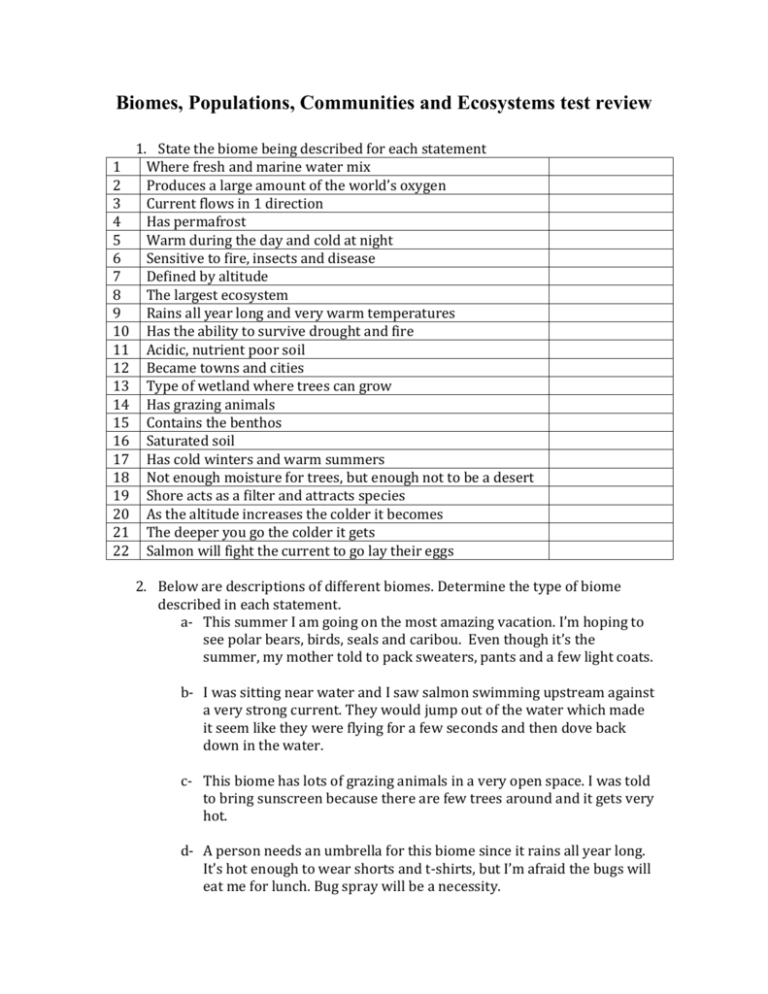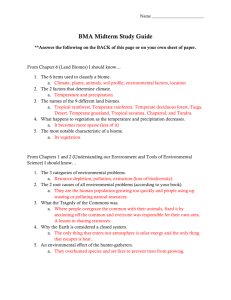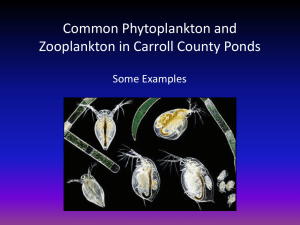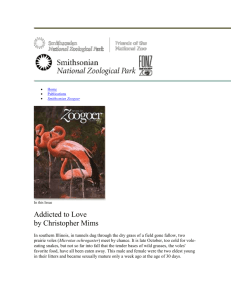Review sheet chapters 8, 9 and 10
advertisement

Biomes, Populations, Communities and Ecosystems test review 1 2 3 4 5 6 7 8 9 10 11 12 13 14 15 16 17 18 19 20 21 22 1. State the biome being described for each statement Where fresh and marine water mix Produces a large amount of the world’s oxygen Current flows in 1 direction Has permafrost Warm during the day and cold at night Sensitive to fire, insects and disease Defined by altitude The largest ecosystem Rains all year long and very warm temperatures Has the ability to survive drought and fire Acidic, nutrient poor soil Became towns and cities Type of wetland where trees can grow Has grazing animals Contains the benthos Saturated soil Has cold winters and warm summers Not enough moisture for trees, but enough not to be a desert Shore acts as a filter and attracts species As the altitude increases the colder it becomes The deeper you go the colder it gets Salmon will fight the current to go lay their eggs 2. Below are descriptions of different biomes. Determine the type of biome described in each statement. a- This summer I am going on the most amazing vacation. I’m hoping to see polar bears, birds, seals and caribou. Even though it’s the summer, my mother told to pack sweaters, pants and a few light coats. b- I was sitting near water and I saw salmon swimming upstream against a very strong current. They would jump out of the water which made it seem like they were flying for a few seconds and then dove back down in the water. c- This biome has lots of grazing animals in a very open space. I was told to bring sunscreen because there are few trees around and it gets very hot. d- A person needs an umbrella for this biome since it rains all year long. It’s hot enough to wear shorts and t-shirts, but I’m afraid the bugs will eat me for lunch. Bug spray will be a necessity. 3. At the beginning of winter there were 15 polar bears in a small area of the arctic. 4 polar bears died because of the lack of food, 3 polar bears left the area to look for food, 2 bears were shot by hunters and 3 bears came to the area to look for food. Was there a population increase or decrease? By how much? 4. You counted 150 dandelions in a 6 m2 area. What is the population density of the dandelions? 5. A population of 33 snowshoe hares lives on an island with an area of 25 000 m2. What is the population density of the hares? 6. Organisms living in the same ecosystem interact; some of these interactions are called ''trophic relationships." nut mushroom squirrel fox a- Give the trophic level for the organisms above b- Using arrows, connect the living organisms to form a food chain. 7. A hare died in a field in December. Explain the steps in the chemical recycling process by describing what happens in each of the months indicated. 8. In recent years, wheat farmers have noticed a sharp increase in the woodland vole population. Wheat, an important food source for humans, is also an important part of the diet of woodland voles. Woodland voles are often labelled as pests since they can carry bacteria and viruses. The farmers are worried about their harvest and are considering the possibility of spreading a rodent poison that will eliminate the voles. Food web for a wheat field: Wheat is a food source for many living things: the stalk for aphids, the leaves for crickets and slugs, and the kernels for voles, sparrows, and humans. a- Give three consequences to the food web if the vole population continues to increase. b- Give an explanation to why the increase in the vole population may have occurred. 9. Draw an example for the following terms on species distribution. Clumped Uniform Random 10. Apple cultivators must consider all aspects of the Orchard’s ecosystem in order to ensure the highest possible crop yield. The trees in the orchard obtain their energy through the process of photosynthesis. Using the following information, identify an autotroph, a decomposer, a first-level consumer and a third-level consumer from the orchard’s food web. (put answers on the diagram) An Apple Orchard’s Food Web Legend: Aphid: Apple tree shoots: Frog: Kite: Ladybug: Snake: Spider: Worms: SOIL 11. The table below lists the contents of two aquariums, A and B, both with a capacity of 50 L. Find the relative abundance of each species. Aquarium A Aquarium B 15 goldfish 27 goldfish 12 striped fish 20 striped fish 10 snails 0 snails 17 green algae 0 green algae 15 fern 80 ferns Which aquarium has the greater biodiversity? Why 12. Use the diagram below to answer the questions. a- Name an animal that could be a second, third or fourth order consumer. Give the food chain for each example. b- Which trophic level is missing from the food web? 13. Use the diagram below to answer the questions. a- What happens to the wolf population when the rabbit population decreases? b- What happens to the rabbit population when the wolf population increases? c- What happens to the rabbit population when the wolf population decreases? d- Even though the population varies for the rabbits and wolves, why do the rabbits always have a higher population? 13. State whether the following examples are biotic or abiotic. a- Competition d- predators b- pH of soil e- sunlight c- temperature f- disease 14. What is the difference between biomass and primary productivity? Multiple choice section 15. With which living organism is primary productivity associated? A) A bee B) A tree C) A cow D) An earthworm 16. Large number of yellow flowers are scattered unpredictably all over a field. What pattern in involved in this case? A) Clumped B) Random C) Dense D) Uniform 17. The table below gives a list of disturbances. Some are natural, and others are the result of human activity. Table I -Different Possible Disturbances Disturbances 1. Volcanic eruption 2. Acid rain 3. Snowstorm 4. Tree cutting 5. Forest fire Which of these disturbances result from natural causes only? A) 1, 2 and 3 B) 1 and 3 C) 1, 3, 4 and 5 D) 2 and 5 18. Match the term with the appropriate example 1- Commensalism A- A bee spreading plant pollen 2- Mutualism B- An owl killing a rabbit for food 3- Parasitism C- A bird using an old abandoned nest for her newborns 4- Predation D- Two bears fighting over territory 5- Competition E- Worms living in your intestines A) 1B, 2C, 3A, 4E, 5D C) 1A, 2C, 3E, 4B, 5D B) 1C, 2A, 3E, 4B, 5D D) 1C, 2A, 3E, 4D, 5B 19. The following diagram shows the food web for the coastal species living off Grand Island. State in which trophic level each organism belongs to. Producers Consumers A Green algae, Shrimp, anemone, urchin, phytoplankton and muscle and crab zooplankton B Green algae, Shrimp, anemone, urchin, phytoplankton and muscle, starfish and crab zooplankton C Green algae and Zooplankton, shrimp, phytoplankton anemone, urchin, muscle and crab D Green algae and Zooplankton, shrimp, phytoplankton anemone, urchin, muscle, crab and starfish Decomposers Bacteria and starfish Bacteria Bacteria and starfish Bacteria 20. Using the same food web as number 20, biologists have noticed a rapid decline in the sea anemone population of the estuary near Grand Island. At first, they thought this was caused by abiotic factors, but they discovered that the direct cause of this rapid decline is a new type of fungus affecting sea anemones only. In the short term, what impact is this disturbance likely to have on the zooplankton population?







